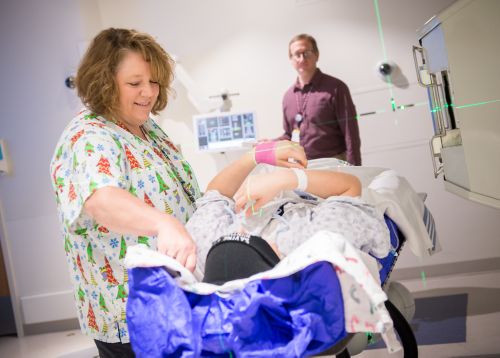Devices to help your child hold still
Mask
The therapists may use a mask (sometimes called an aquaplast mask) to hold your child’s head in the proper treatment position. The mask is made with a flat piece of plastic that has small holes in it, like mesh. When your child is in the correct position on the table, the plastic piece is placed in warm water. The therapist will give the plastic a few seconds to cool and then will place it on your child’s face and stretch it down over the chin. The warm water loosens the plastic, which helps the mask form over the face. It will feel very warm and wet but will cool quickly. Many patients say it feels like a warm washcloth on their face. As it dries, the plastic hardens to form a facemask. Your child will be able to breathe easily through the holes in the mask.
Headrest
The therapist will also make a mold to go under your child’s head when they are lying on their back. The mold is a cloth bag filled with beads. The therapist adds water into the bag, and the beads harden so the mold forms into the shape of the back of your child’s head. This will make it more comfortable for your child to hold their head in the exact position needed for treatments. The mask and head mold will be used for each treatment to hold your child’s head in the correct treatment position.
If your child will be lying on their stomach during treatment, a similar facemask will be used. When your child is lying on their stomach with their face in the mask, the therapist will place an oxygen tube in the space between the table and the mask so that your child will be able to breathe easily.
Body mold
During simulation, staff may also make customized body molds, sometimes called a vac lock bag, to position your child. A vac lock bag can be used to support the head, abdomen, leg, or another part of the body. Your child will lie on their back on the bag. The vac lock bag feels squishy, like a beanbag. A vacuum will remove the air from the bag, so it molds around your child’s body.
Alpha cradle
An alpha cradle is used if your child needs Total Body Irradiation (TBI). If your child needs an alpha cradle for treatment, they will lie on the TBI table on top of a vac lock bag. The radiation therapist will pour a foaming solution inside a plastic bag called an alpha cradle and place it on top of your child like a blanket. The bag will harden and form the shape of their body. The bag will feel warm and will harden within 10 to 20 minutes. The bag will be used each time your child has radiation treatment to hold their body in the proper treatment position.

